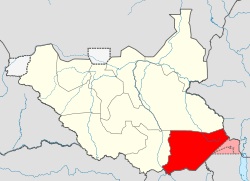E. Equatoria warns Jonglei over Kasengor district ownership
By Ijoo Bosco
April 29, 2014 (TORIT) – The government of South Sudan’s Eastern Equatoria state has warned administration of neighbouring Jonglei state to stay away from Kasengor payam [district], saying it was part of its Kapoeta East county and not Pibor.

The debate was instigated after a motion was raised by Benjamin Lopeyok Kumuya, who represents Kapoeta East county constituency in the state assembly.
The MPs recommended that a committee be formed and tasked to inform the Council of States members in the national assembly about the matter. They also resolved that the central government intervenes to prevent further tension.
The motion, Kumuya said, was tabled before MPs after some individuals from Jonglei claimed the Jie community in Kasengor were under Pibor county administration.
“The claim is confirmed by a letter — Ref: RSS/MoD/OM/BJ/0327/14 — dated 1 April 2014 from former Jonglei governor, Kuol Manyang Juuk, who was appointed as South Sudan’s minister of defence last year,” the lawmaker told Sudan Tribune.
Juuk, according to the MP, directed the defense ministry undersecretary to release two vehicles to the “Jie community in Kasengor payam [district] of Pibor county.”
“The Jie people strongly reject and condemn the implication that Kasengor is part of Pibor county and not Eastern Equatoria”, MP Kumuya retorted.
“The origin of the Jie people can be traced to the largest group of Nilo-hamites of the Great Lakes region, who lived around Lake Turkana from around 14th century and later move to Karamojong region in northern Uganda,” he stressed.
According to the MP, that the last migration of the Jie people from Uganda was at the beginning of 17th century when they came and settled around Lokaalen river in what is now Kapeota East county in Eastern Equatoria state.
“The Mogos section of the Jie people settled in Lomongole with the migration of their kinsmen, the Toposa from Najie in the Karamonjong region but they were forced to settle around Kuron, Kasengor and Lopyet due to conflict with the Oromo of Ethiopia”, the lawmaker said.
“The Jie [community] who were living in Kuron, were forced to relocate to Boma after the intervention of the Italian administration in 1935,” MP Kumuya added.
(ST)
